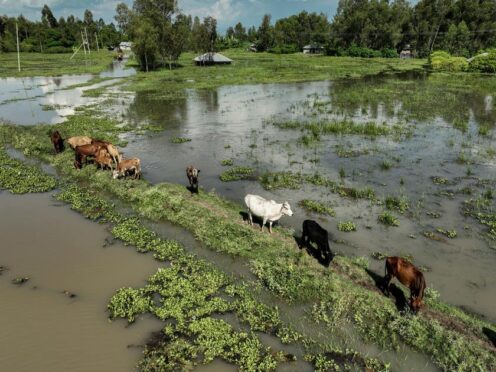Deadly floods have caused havoc in many parts of East Africa, with Burundi calling for international help to deal with the aftermath of torrential rainfall.
Lake Tanganyika’s rising waters have invaded the port of Bujumbura, Burundi’s economic capital, disrupting business there and elsewhere in the country that relies heavily on donor support to run government programmes.
Interior minister Martin Niteretse said earlier this month: “We are issuing this statement to ask our development partners to combine efforts with the state of Burundi to help all people affected by these disasters.
“We need that support.”
Between September and April 7, some 203,944 people were affected by flooding, with 19,250 homes and 209 classrooms destroyed. The number of people internally displaced by flooding rose by 25%, reaching over 98,000, according to Violet Kenyana Kakyomya, the UN resident coordinator in Burundi.
To protect people forced to flee, we must also protect the environment where they find refuge. No action is too small.
On this #EarthDay, we must step up efforts towards a cleaner, greener future & protect the displaced from the worsening climate crisis. pic.twitter.com/ub6xKRzElo
— UNHCR East, Horn of Africa and Great Lakes (@RefugeesAfrica) April 22, 2024
Burundi is one of the world’s poorest countries, with 80% of its 13 million people employed in agriculture, according to the World Bank.
Flooding there has created surreal scenes like game rangers entering the waterlogged Rusizi National Park in a canoe.
The Boulevard du Japon, a major highway in Bujumbura, has been flooded in recent days.
Climate experts say flooding in Burundi and elsewhere in the region is part of extreme conditions linked to the El Nino weather phenomenon.
“It must be said directly that these floods are associated with climate changes that affect Burundi like other countries in the region,” said Jean Marie Sabushimike, a geographer and disaster management expert who teaches at the University of Burundi.
While climate change is the trigger, the impact of the flooding is exacerbated by poor land-use planning “that does not take into account areas at very high risk of flooding”, he said.
The rising waters of Lake Tanganyika have caused the Kanyosha river to overflow, damaging homes and other property in Bujumbura.
Some in the city have been unable to return to their homes — or leave.
Joachim Ntirampeba, a resident of the village of Gatumba near the Congo border, said that while he had witnessed many flooding events over the years, this time “it’s terrible”.
He said it is “the first time” he’s seen such heavy flooding.
Meanwhile, in Kenya, 35 people have died since mid-March in flooding events that have affected more than 100,000 people, according to the UN, which cites Red Cross figures in the most recent update.
Some residential areas in Nairobi, the capital, flooded as rivers broke their banks on Sunday night.
The Kenyan government agency in charge of roads warned Nairobi residents to avoid flooded highways, including one to the coastal city of Mombasa. Those who live by the Nairobi river were urged to move to higher ground.
Flooding and mudslides have also been reported in western Kenya. In the northern region, a passenger bus was swept away by floodwaters on a bridge earlier in April, with disaster avoided after 51 passengers were rescued.
Kenya’s meteorology department predicts that rainfall will peak this week.
